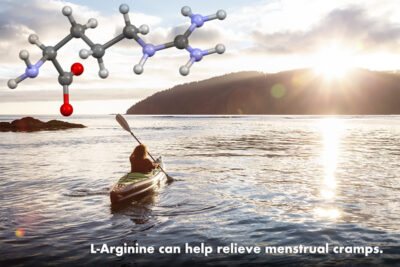For MENSTRUAL CRAMPS, L-arginine helps the body to make nitric oxide, which encourages blood vessels to open wider, improving blood flow to the uterus and other organs, and easing menstrual cramps. L-arginine is a semi-essential amino acid necessary for protein synthesis, and a building block for making nitric oxide. Though adult bodies make some arginine, and it is found naturally in foods such as red meat, poultry, fish, nuts, seeds and legumes. Women who are prone to dysmenorrhea tend to require higher amounts of L-arginine.
 The inner lining of blood vessels, the endothelium, sends nitric oxide as a signaling compound to the surrounding smooth muscle of the vessels. The smooth muscle relaxes, blood vessels open up, known as vasodilation, and blood flow increases. Nitric oxide also helps blood vessel health by preventing the smooth muscle from over-developing, by limiting the clumping of platelets that can cause clots, and by reducing white blood cell adhesion to the endothelium which also reduces clot risk.2
The inner lining of blood vessels, the endothelium, sends nitric oxide as a signaling compound to the surrounding smooth muscle of the vessels. The smooth muscle relaxes, blood vessels open up, known as vasodilation, and blood flow increases. Nitric oxide also helps blood vessel health by preventing the smooth muscle from over-developing, by limiting the clumping of platelets that can cause clots, and by reducing white blood cell adhesion to the endothelium which also reduces clot risk.2
Primary dysmenorrhea is a syndrome characterized by painful uterine contractions, exacerbated by a hypersecretion of certain varieties of endometrial prostaglandins that increase inflammation. In vivo and in vitro studies have demonstrated that myometrial cells, making up the uterus muscle layer, are also targets of the relaxant effects of nitric oxide. In an open, cross-over, controlled design, a total of twenty-four patients with the diagnosis of severe primary dysmenorrhea were studied during two consecutive menstrual cycles. Those who received nutrients to boost nitric oxide continued to experience effective relief from menstrual pelvic pain for two hours as opposed to the significantly reduced 30-minute time-period in controls.4
In addition to relieving cramps by improving blood flow, arginine can improve the symptoms of menstrual cramps by relieving depression and anxiety. Depression and anxiety symptoms have long been found to be associated with severe menstrual cramping. Several studies have shown that arginine can ease both depression and anxiety. Women who experience depressive symptoms are known to have lower arginine levels in their blood.
L-arginine was first recognized in the extract of a lupin seedling in 1886 by a Swiss chemist Ernst Schultze. Nitric oxide is a natural blood vessel-opening molecule for mammals. It occurs in the cells of almost all types of organisms, ranging from bacteria to plants, fungi, and animals. Nitric oxide is made within cells from L-arginine, oxygen, and NADPH. Each nitric acid molecule lives for only a few seconds. Arginine is best known for its effects on the vascular system: it is a substrate for the nitric oxide synthase (NOS) enzyme. NOS, in vascular endothelial cells, converts arginine to nitric oxide, also known as endothelium-derived relaxation factor, which causes vasodilation. Arginine can help dysmenorrhea because it relaxes blood vessels and helps them to open up, increasing blood flow to and from the uterus and other organs.
Dosing of arginine varies in clinical practice, and safety studies have found a dose up to 20,000mg to have no adverse effects. L-arginine is best in a sustained-release form, because of its short action. Plain L-arginine is rapidly metabolized and used up by the body, so blood levels drop fast if it is not taken frequently throughout the day. Sustained-release L-arginine maintains ample tissue levels of L-arginine over 24 hours at doses of 500 to 1,000mg two times daily.
Recommendation:: L-arginine 500 to 1,000 mg twice daily, or as directed by your healthcare provider.
References
- Ali-Sisto T et al. Global arginine bioavailability ratio is decreased in patients with major depressive disorder. J Affect Disord. 2018 Mar 15;229:145-151.
- Bode-Boger SM, Boger RH, Galland A, et al. L-arginine-induced vasodilation in healthy humans: pharmacokinetic-pharmacodynamic relationship. Br J Clin Pharmacol 1998;46:489-97.
- Fall, M., et al. “EAU guidelines on chronic pelvic pain.” European urology 46.6 (2004): 681-689.
- Facchinetti, Fabio, et al. “A comparison of glyceryl trinitrate with diclofenac for the treatment of primary dysmenorrhea: an open, randomized, cross-over trial.” Gynecological endocrinology 16.1 (2002): 39-43.
- Zahradnik, Hans-Peter, Aida Hanjalic-Beck, and Klaus Groth. “Nonsteroidal anti-inflammatory drugs and hormonal contraceptives for pain relief from dysmenorrhea: a review.” Contraception 81.3 (2010): 185-196.